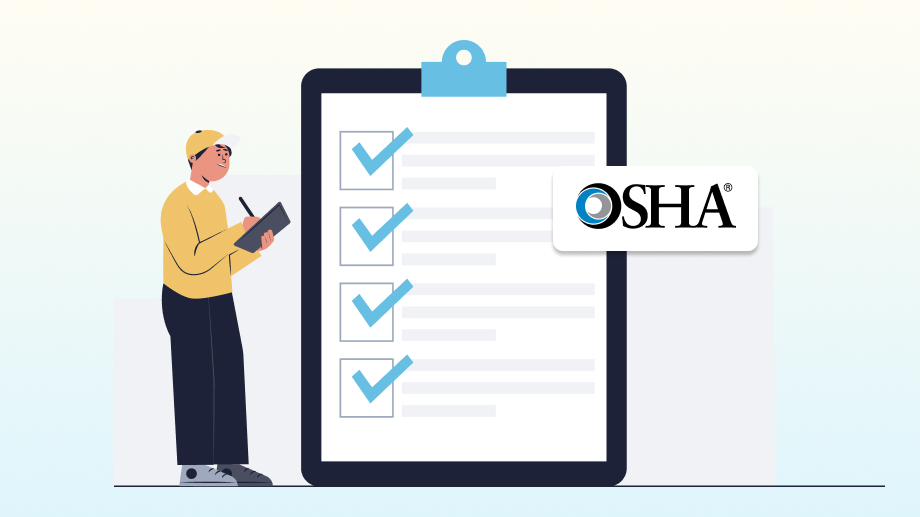
The term “OSHA inspection” often stirs worry or frustration among safety professionals, managers, and business owners across industries. However, with the right outlook and preparation, you can transform these inspections into opportunities to enhance workplace safety. By adopting a proactive approach before, during, and after an OSHA inspection, you can ensure a safer environment for your employees.
Handling OSHA inspections the right way starts with knowing what to expect. Read ahead to understand what you can expect during an OSHA inspection and how to navigate it with efficient construction workforce management.

What to Expect from an OSHA Inspection?
OSHA, the Occupational Safety and Health Administration, is part of the U.S. Department of Labor. Its mission is to ensure healthful and safe working conditions by creating and enforcing standards, providing outreach, training, assistance, and education.
Workplaces rarely receive advance notice of an OSHA inspection. Inspectors will arrive unannounced, show their credentials, and follow a typical inspection pattern, including an opening conference, a walkaround, and a closing conference. OSHA must complete inspections within six months, although most take only a few days.
Types of OSHA Inspection
OSHA inspections can be triggered by various scenarios. Each type of inspection serves a critical function in maintaining safety standards at construction sites. By understanding the triggers and focus areas for each type of inspection, contractors and subcontractors can better prepare for OSHA inspections and address safety issues.
Complaint-based Inspections
Complaint-based inspections occur when an employee, union, or external party files a complaint about a specific hazard or OSHA safety standards’ violence. OSHA inspectors, also known as compliance officers, will investigate the issue. Inspectors primarily focus on the complaint but have the authority to cite any immediate life and health dangers they discover, even if they are unrelated to the complaint. This thorough approach ensures that all hazardous aspects of the site are addressed.
Scheduled Inspections
Scheduled inspections are part of OSHA’s regular activities, analyzing systemic safety concerns rather than focusing solely on obvious issues. These comprehensive inspections assess adherence to several OSHA standards applicable to high-risk areas like confined space entry, hot work procedures, fall protection, electrical safety practices, and conditions leading to caught-between or struck-by accidents. These inspections often result in actionable feedback, allowing construction sites to improve their safety protocols and practices.
Inspections Triggered by Visible Hazards
OSHA has the authority to intervene immediately if they notice an unsafe situation on a construction site, even during an unplanned visit. This may happen if a compliance officer notices hazards that present immediate danger to the health and life of people onsite. If an inspector notices a hazard, they can halt work, conduct a thorough investigation, and even issue citations for safety violations. This process can lead to prompt corrective action and prevent future incidents. Fall protection tops the list of the most common OSHA violations in the construction industry.
Invitational Inspections
General contractors or site superintendents who seek expert advice on improving safety can invite OSHA inspectors to their site for a consultation. These proactive inspections foster a cooperative relationship between OSHA and the contractor. During these inspections, OSHA inspectors provide recommendations and advice but usually don’t issue citations. This approach shows the contractor’s commitment to worker safety and can result in a stronger safety culture and better OSHA compliance, leading to fewer accidents and injuries.
Incident or Injury-triggered Inspections
One of the primary reasons OSHA visits construction jobsites is to conduct inspections following an incident or injury. Employers are legally required to report severe incidents, such as hospitalization, amputation, loss of an eye, or a fatality, to OSHA within a specific period. OSHA conducts investigations following these reports to identify safety standard violations that may have contributed to the incident. These inspections aim to prevent future accidents from occurring and ensure worker safety.
The OSHA Inspection Process: 6 Key Steps
Understanding each stage of an OSHA inspection helps construction organizations prepare effectively.
- Preparation & Initial Arrival- Inspectors gather background information about the site before arrival.
Upon arrival, they validate their identity and may conduct remote inspections for minor issues. Employers must respond in writing within five working days to remote actions. - Opening Conference- The inspector presents their credentials and holds an opening conference with the employer and employee representative. They specify the inspection’s scope, outline the audit’s purpose, and request documentation like injury logs and safety plans.
- Walkthrough Inspection- The inspector and site representatives conduct a walkthrough to spot dangerous or unhealthy practices. The inspector documents conditions and addresses any immediate dangers. An employee representative can accompany the inspector.
- Employee Interviews- Inspectors may privately interview employees to gather information about safety practices and workplace conditions. Employees have the right to request private interviews or have a representative present.
- Closing Conference- The inspector discusses findings with the employer and employee representative, including any unsafe conditions and potential citations. This meeting provides an opportunity to clarify questions and understand compliance steps.
- Post-inspection Actions- The inspector compiles a report of findings, and OSHA issues citations if violations occur. Citations describe the violation, propose a correction timeline, and assess penalties if applicable. Employers must correct cited conditions, pay penalties, or dispute findings.
How Can Your Business Prepare For an OSHA Inspection?
Proper preparation is crucial for handling an OSHA inspection effectively. Here are five ways you can prepare for a random or expected OSHA inspection.
Perform Hazard Assessments
OSHA requires employers to perform a job hazards analysis for every type of job that employees will perform within the workplace. They define the term “hazard” as the potential for harm. Hence, they require this analysis so you can better identify hazards on your job site or within your workplace before they happen. It focuses on the relationship between workers, their environment, the tools used for the task, and the task itself.
One effective way to reduce safety hazards is by adopting a lone worker safety app, which includes threat escalation features. Such an app allows you to set up a safety workflow to monitor employee safety and detect any threats in real time. Workflows can be customized to fit your security protocol, enabling you to set up custom criteria and rules to validate threats before escalation.
Conduct Safety Trainings
Your OSHA inspector is going to check whether your employees have received the proper safety training to safely perform their tasks. Employee safety training should also be up-to-date, meaning an employee’s safety certificates should be current and recently achieved.
You may need to present proof of your employees’ completed and current safety training, as it may be impossible that the inspectors check each employee individually. One easy way to prove your employee’s safety training is keeping a digital record. Most worker safety apps provide forms for businesses to maintain a record of any work done. Same can be done for the training sessions or toolbox talks.
Keep Comprehensive Records
One of the best ways you can prepare for an OSHA inspection is to keep good records every single day. Your OSHA inspector is going to ask to see various reports, records, and other pieces of information. Being able to present these documents easily and in an organized way will speak volumes about your company’s devotion to safety protocol. Keep records of every training course your employees complete.
allGeo simplifies compliance by providing comprehensive custom reports and analytics within manager dashboards. Using it you can track individual records and training completions in real-time, ensuring that all employee certifications are up-to-date and easily accessible. By leveraging the analytics features, you can identify trends, potential safety issues, and areas needing improvement.
Perform Internal Audits
Third-party audits are a great way to get objective feedback about the true success of your safety program. But an internal audit, while hard to keep completely bias-free, is also an excellent way to learn more about your workplace’s current safety levels before an OSHA inspector shows up at your doorstep.
As a safety professional, you can oversee internal audits to get the crucial information you need on how your safety program is performing. Use your findings to make changes where necessary and find areas of potential noncompliance you may have been unaware of.
What Happens After an OSHA Inspection?
After an OSHA inspection, you will likely have a list of deficiencies in your safety program. This is an opportunity to improve workplace safety.
- Addressing Deficiencies: Review the inspection report with your safety team, managers, and other relevant parties. Plan and implement changes to correct each deficiency. Write a follow-up letter to the inspector detailing the actions taken to address the concerns.
- Handling OSHA Citations: If you receive an OSHA citation, it will describe the safety violation and reference the relevant standard. Citations include a timeframe for correction and must be posted prominently in the workplace. Follow the instructions to remedy the situation and address the violation promptly.
- OSHA Contests and Informal Conferences: You can contest citations within 15 days of receiving them by filing a case with the review commission. Alternatively, request an informal conference to discuss the citations, penalties, and inspection findings. This conference must also occur within the 15-day period. During the conference, OSHA officials will explain the purpose, participants’ rights, contest rights, and potential settlements.
You have the right to request an OSHA inspection by completing an official complaint form if you identify imminent dangers in your workplace. This proactive step can help improve safety conditions for your workers.
Conclusion
OSHA inspections should be viewed as opportunities to enhance workplace safety. By comprehending the inspection process and adopting proactive strategies, construction companies can ensure compliance and cultivate a culture of safety excellence.
OSHA is just one of the many field service compliance requirements your business might face. Implementing tools like a lone worker safety app can help ensure safety compliance. However, depending on your business and the labor laws that govern it, investing in a field service workforce management app yields immediate benefits. Visit https://www.allgeo.com/field-service-software-demo to know more.
